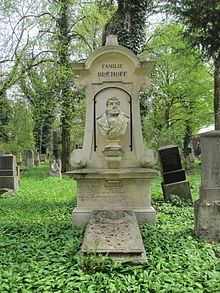Friedrich Tiedemann
Friedrich Tiedemann | |
|---|---|
Heinrich Tiedemann (son) | |
| Scientific career | |
| Fields | Anatomy |
| Doctoral advisor | Johann Wilhelm Christian Brühl[1] |
| Other academic advisors | Conrad Moench Georg Wilhelm Stein Adalbert Friedrich Marcus Carl Caspar von Siebold Franz Kaspar Hesselbach Georges Cuvier |
| Signature | |
Friedrich Tiedemann
Tiedemann spent most of his life as professor of anatomy and physiology at
Life
Tiedemann was born at Cassel in Prussia (now central Germany), the eldest son of Dietrich Tiedemann (1748–1803), a philosopher and psychologist of considerable repute.
Friedrich studied medicine at
From 1804, he became a
He was elected a Foreign Fellow of the
He died in Munich on 22 January 1861. He is buried in the Alter Südfriedhof in Munich (Old South Cemetery).
Viewpoints

Tiedemann devoted himself to the study of natural science, and, upon moving to Paris, France, became an ardent follower of
Tiedemann was one of the first persons to scientifically contest racism. In his article entitled "On the Brain of the Negro, compared with that of the European and the Orang-outang" (1836), he argued based on craniometric and brain measures taken by him from Europeans and black men from different parts of the world that the then-common European belief that Negroes have smaller brains and are thus intellectually inferior is scientifically unfounded and based merely on the prejudice of travellers and explorers.[5][6][7]
In 1827, he became a correspondent of the Royal Institute of the Netherlands, and when that became the Royal Netherlands Academy of Arts and Sciences in 1851, he joined as a foreign member.[8] He was elected a Foreign Honorary Member of the American Academy of Arts and Sciences in 1849.[9]
Tiedemann was influenced by
By the 1860s, the tobacco historian Friedrich Tiedemann had reported several
Family
In 1807, he married Frauline von Holzing. He was later married to Charlotte Hecker.
He had a daughter Elise.
One of Tiedemann's sons,
His son Heinrich immigrated to Philadelphia and became a physician in Philadelphia's Germantown Hospital. Perhaps influenced by his father's work, he objected to the Darwinian contention of a continuity between humans and apes.[15]
Legacy
In 2007, Brazilian geneticist Sergio Pena called Tiedemann an "anti-racist ahead of his time".[16]
Works (translated)
- Tiedemann, Friedrich (1813). Friedrich Tiedemann's Anatomy of Headless Abortions: along with four copper plates. Landshut.
- Tiedemann, Friedrich (1816). Anatomy and history of the brain's formation in the fetus of man, together with a comparative account of the structure of the brain in the animals. Nuremberg.
- Tiedemann, Friedrich (1821). Friderici Tiedemann Anatomists Et Physiologiae in Academia Heidelbergensi Professoris Icones Cerebri Simiarum Et Quorundam Mammalium Rariorum. Heidelberg.
- Tiedemann, Friedrich (1822). Friderici Tiedemanni Tabulae arteriarum corporis humani / Friederich Tiedemann's Illustrations of the arteries of the human body (explanations). Karlsruhe, Heidelberg.
- Tiedemann, Friedrich (1822). Friderici Tiedemanni Tabulae arteriarum corporis humani / Friederich Tiedemann's Illustrations of the arteries of the human body (panels). Karlsruhe, Heidelberg.
- Tiedemann, Friedrich; Gmelin, Leopold (1827). Some new constituents of bile of the ox. Leipzig.
- Tiedemann, Friedrich (1829). Anufuf to the humanity of the higher authorities of justice care in Germany, caused by a beheaded on 22 October 1827 in Heidelberg beheading. Darmstadt.
- Tiedemann, Friedrich (1837). The Negro's Brain Compared With The European And Orang-Outang: With Six Panels. Heidelberg.
- Tiedemann, Friedrich (1840). Of the Duverneyschen, Bartholin's or Cowper's glands of the woman, and the oblique shape and position of the uterus: With four panels of illustrations. Heidelberg, Leipzig.
References
- ^ Neurotree profile Friedrich Tiedemann
- ^ a b c Chisholm 1911.
- ^ "Archived copy". Archived from the original on 3 February 2018. Retrieved 4 August 2016.
{{cite web}}: CS1 maint: archived copy as title (link) - ISBN 0-902-198-84-X. Archived from the original(PDF) on 4 March 2016. Retrieved 16 December 2018.
- Bibcode:1836RSPT..126..497T.. Tiedemann was heavily criticized in medical journals at the time, including by Andrew Comb, Remarks on the Fallacy of Professor Tiedemann, Eclectic Journal of Medicine (1838).
- ^ Mitchell, P.W. (2018). "The fault in his seeds: Lost notes to the case of bias in Samuel George Morton's cranial race science." Public Library of Science Biology 16 (10): e2007008.
- ISBN 978-1-4985-6386-4. Retrieved 2019-07-26.
- ^ "Friedrich Tiedemann (1781–1861)". Royal Netherlands Academy of Arts and Sciences. Retrieved 20 July 2015.
- ^ "Book of Members, 1780–2010: Chapter F" (PDF). American Academy of Arts and Sciences. Retrieved 9 September 2016.
- ISBN 978-0674062214
- ISBN 978-0226712161
- S2CID 3988649.
- ^ Proctor, R.N. Tobacco and the global lung cancer epidemic. Nature. October 2001, 1(1):82–86.
- ISBN 978-1400153503
- ^ Tiedemann, Heinrich. (1876). Mensch und Affe: eine Vorlesung welche am 3. Februar 1876 in der Halle der Teutschen Gesellschaft zu Philadelphia gehalten wurde. German Society of Philadelphia.
- ^ Pena, Sergio (2007). "Um anti-racista à frente de seu tempo". Ciencia Hoje. Instituto Ciencia Hoje. Retrieved 6 April 2013.
Um anti-racista à frente de seu tempo
Attribution:
- This article incorporates text from a publication now in the public domain: Chisholm, Hugh, ed. (1911). "Tiedemann, Friedrich". Encyclopædia Britannica. Vol. 26 (11th ed.). Cambridge University Press. p. 962.
